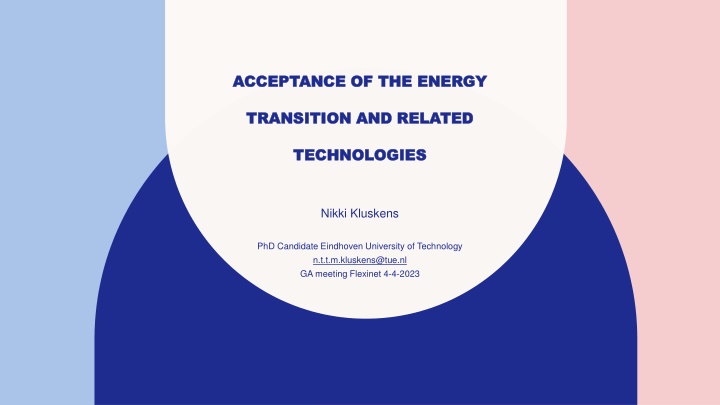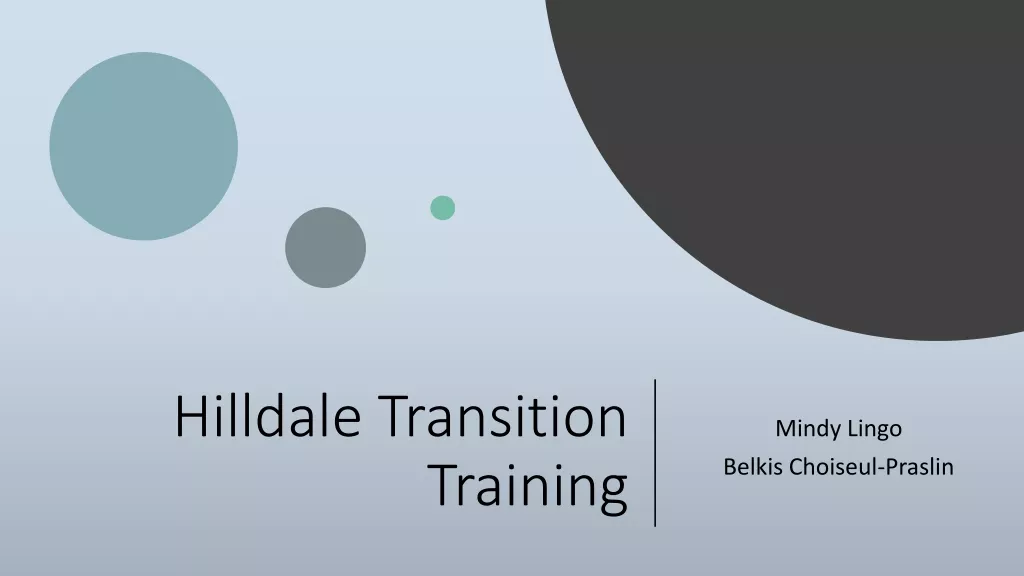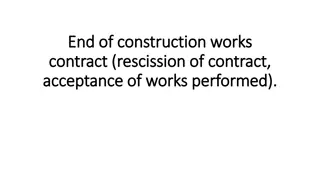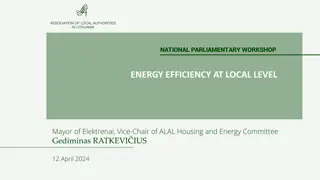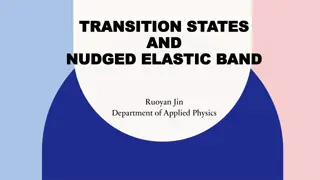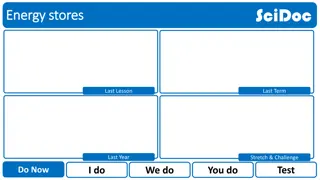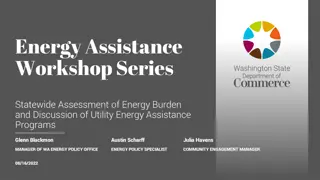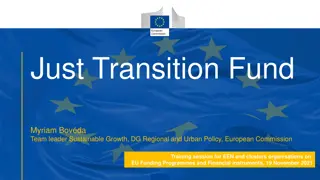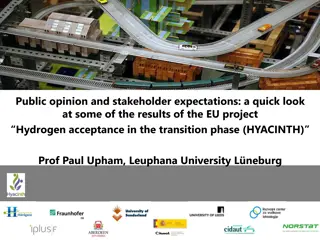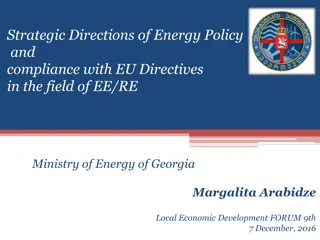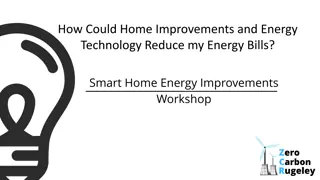Importance of Acceptance in Energy Transition
The concept of acceptance and its complexities in the context of energy transition and related technologies are explored, highlighting the urgent need for system change and the various responses from key actors shaping acceptance processes. Factors influencing acceptance, actors involved, and different dimensions of acceptance are discussed with insights from research and real-world examples.
Download Presentation

Please find below an Image/Link to download the presentation.
The content on the website is provided AS IS for your information and personal use only. It may not be sold, licensed, or shared on other websites without obtaining consent from the author.If you encounter any issues during the download, it is possible that the publisher has removed the file from their server.
You are allowed to download the files provided on this website for personal or commercial use, subject to the condition that they are used lawfully. All files are the property of their respective owners.
The content on the website is provided AS IS for your information and personal use only. It may not be sold, licensed, or shared on other websites without obtaining consent from the author.
E N D
Presentation Transcript
ACCEPTANCE OF THE ENERGY ACCEPTANCE OF THE ENERGY TRANSITION AND RELATED TRANSITION AND RELATED TECHNOLOGIES TECHNOLOGIES Nikki Kluskens PhD Candidate Eindhoven University of Technology n.t.t.m.kluskens@tue.nl GA meeting Flexinet 4-4-2023
AGENDA Theoretical insights acceptance concept Factors important for acceptance Acceptance in relation to Flexinet Workshop
3 IMPORTANCE OF ACCEPTANCE Call for urgent system change Acceptance getting specific policy attention Research showing examples of delay or cancellations (Aitken et al. 2008; Devine-Wright 2011) Risk of severe environmental costs (Soma and Haggett 2015) We only need social acceptance!
4 COMPLEXITIES OF ACCEPTANCE: A CONCEPT WITH MULTIPLE DIMENSIONS ACTORS (WHO) ROLES RESPONSES (HOW) OBJECTS (WHAT)
5 ACTORS AND ROLES WHO ARE ACCEPTING First and second dimension of acceptance
6 Socio-political acceptance Public Key- stakeholders Policymakers Local authorities Local residents Local stakeholders Consumers Investors Firms Community acceptance Market acceptance Figure adjusted from W stenhagen et al. 2007;complemted with insights from Landeta- Manzano et al. 2018)
7 ACTORS SHAPING ACCEPTANCE PROCESSES All these actors are embedded in social interaction and have different roles in different parts of society (Wolsink 2010). Depending on role they have (or is allocated to them) they shape, to a greater of lesser extend, acceptance processes of the energy transition and related technologies (Van Rijnsoever et al. 2015) Through different forms of engagement and social interaction in energy transition processes. Passively or actively (doing nothing vs. support or using a technology) Moreover, actors can have explicit formal or informal roles (authorities vs. citizens) Actors and roles important to look at when talking about acceptance
8 RESPONSES HOW ARE ACTORS ACCEPTING Third dimension of acceptance
9 VARIOUS ACCEPTANCE RESPONSES Complications because of related connotations: support, acceptability, tolerance. Support is more favorable position towards something (project), acceptance is more passive form of response (tolerance) Batel et al., 2013 Acceptance is not a single outcome, but range of possible approval responses, from passive to active Bertsch et al., 2016 Allows for silence being considered an acceptance response as well in the context of RE technologies and policies.
10 FACTORS HINDERING/ FACILITATING ACCEPTANCE RESPONSES Many factor can hinder/ facilitate acceptance responses of these actors Does not say anything about the steerability. Not a checking the box list. Based on literature review: see last slide
11 OBJECTS WHAT ARE ACTORS ACCEPTING Fourth dimension of acceptance
12 VARIOUS OBJECTS OF ACCEPTANCE System change towards a sustainable energy system requires alteration on several levels. Many decision involved in energy transition. (Wolsink, 2012) For example, wind energy (as a source in the grid, technology as such), but also applies for Flexibility technologies. Distribution of decision-making (from international to local) often leads to more concrete decision on local level has consequences for what is being accepted. (Perlaviciute and Squintani 2020). Difference between aspects that are subject to acceptance (socio- political vs. community acceptance) On local level this often comes down to; decision on concrete projects, location of RET, types of innovation, process, distribution of benefits.
13 OVER TIME
14 ACCEPTANCE BEING MULTIDIMENSIONAL AND NOT STATIC Looking at all these different dimension acceptance can hardly be understood as one-dimensional & one time decision. Acceptance inherently related to the dimension time U-turn effect (Wolsink, 2007) Attitudes are dynamic and can change over time: depending on changing circumstances. Source: Wolsink, 2007
15 RESULTS RESEARCH: IN THE CONTEXT OF WIND A SOLAR PROJECTS IN THE NETHERLANDS
ACCEPTANCE CONSISTING OF ACCEPTANCE CONSISTING OF MULTIPLE DIMENSIONS MULTIPLE DIMENSIONS 16 Responses differ within actor groups. Responses do not change that much over time, but rather relate to liking one aspect of an implementation process over another. For example liking RET, but not location OR not liking RET, but liking distribution of benefits. What stood out: technology is just one of many aspects that people consider when developing their acceptance responses. Actors like different aspects of a project. Objects differ across scales, but also within scales. Technology just being one of the many aspects respondents consider important for acceptance Participation: not everyone wants to participate in same way and should be inclusive in the way it can meet different needs.
17 FACTORS INFLUENCING ACCEPTANCE
LITERATURE REVIEW LITERATURE REVIEW 18 Based on a categorization from relevant (1) to maybe relevant (2) to not relevant (3), 88 articles were selected for a in depth review on social acceptance. Out of these 88 articles only 24 articles talked about factors influencing acceptance. This selection was used to create an overview (following dia) of relevant factor for social acceptance in the context of the energy transition and green design.
19 Based on literature review: see last slide
PROBLEM WITH ONLY LOOKING AT PROBLEM WITH ONLY LOOKING AT FACTORS FACTORS 20 They do not say anything about steerability Most cases are based on Opposition (so we know what can hinder acceptance) Hypothetical (= more general = socio-political acceptance) This is what they call gap between socio-political acceptance & community acceptance Concreteness thus plays a role people can respond different over time when innovations are concretely implemented/play out. How to do research what people find important when things are not concrete yet: difficult to oversee all implications Therefore VSD + information provision needed
VSD APPROACH (RELATION VSD APPROACH (RELATION ACCEPTANCE RESEARCH WITH ACCEPTANCE RESEARCH WITH FLEXINET) FLEXINET) 21 With the VSD we try to understand what is important for people and what that would mean for design criteria for the technologies being developed in Flexinet. Interviews: Current state of knowledge What are important values that need to be met in order to accept something
CURRENT STATE OF KNOWLEDGE CURRENT STATE OF KNOWLEDGE 22 Codes Changing energy resources Explanations from interviews A conversation about passing from fossil to renewable energies Changing the use of fewer fossil fuels to renewable energy like solar or hydrogen The way we produce energy and how we store that and share that among everyone It is more difficult and less available compared to the past I think it is diversification of the energy mix, suppliers and everything also change to alternative carbon sources . Diversification of energy sources Another way of using energy Changing energy use It has a lot to do with behaviors, because in the past nobody cared about where their energy is coming from I see it as something positive and I see the need for it Positivity In my country it is very centralized, we need to decentralize . Change in how we look at energy and our use of it. It is mainly awareness about that energy is not finite.. and that we have to think about how we divide that equally among everyone Changing energy suppliers Change in perception
23 VALUES IMPORTANT FOR ACCEPTING THE ENERGY TRANSITION AND VALUES IMPORTANT FOR ACCEPTING THE ENERGY TRANSITION AND RELATED TECHNOLOGIES (WITHOUT INFORMATION PROVISION) RELATED TECHNOLOGIES (WITHOUT INFORMATION PROVISION) Values important in energy transition (daily life/in general) Values important for acceptance Availability of energy Affordability Sustainable sources of energy Viability of proposed solution Affordability (economically) Sustainability of technology (in terms of environment/ within the system) Accessibility Practicality Gradualism in change Fair Control Exclusion of negative feedback loops Comfortability Simplicity Fulfillment of basic needs Engaging Clear cost-benefit
RESULTS WORKSHOP GREEN RESULTS WORKSHOP GREEN VILLAGE VILLAGE 24 Providing information + asking them again what factors / values are important for them after knowing more about the innovations of Flexinet We did this step to see whether other factors were going to be mentioned as soon as people know more about an innovation. Interestingly, things that came up: autonomy, fairness, comfort. So, this does not differ that much from the factors that came up without the provided information. What stood out: Finding a common language between residents and partners was difficult. Addresses the need for understandable information provision. This is the first time in my life that I had to explain the difference between AC and DC grid
25 WORKSHOP WORKSHOP DEVELOPING A COMMON UNDERSTANDABLE LANGUAGE What are you developing? Why? What problem is it going to solve? What are its current implications? Noise, space, costs etc.. UNDERSTANDING OF WHAT FACTORS ARE IMPORTANT TO ALL ACTORS What factors are most relevant for you as designers/partners within the Flexinet project? What factors are least relevant for you as designers/partners within the Flexinet project? Which factors are met the most? For which factors do you foresee problems
REFERENCES REFERENCES 26 Aitken M (2010) Why we still don t understand the social aspects of wind power: A critique of key assumptions within the literature. Energy Policy 38:1834 1841. https://doi.org/10.1016/j.enpol.2009.11.060 Batel S, Devine-Wright P, Tangeland T (2013) Social acceptance of low carbon energy and associated infrastructures: A critical discussion. Energy Policy 58:1 5. https://doi.org/10.1016/J.ENPOL.2013.03.018 Bertsch V, Hall M, Weinhardt C, Fichtner W (2016) Public acceptance and preferences related to renewable energy and grid expansion policy: Empirical insights for Germany. Energy 114:465 477. https://doi.org/10.1016/j.energy.2016.08.022 Devine-Wright P (2011) Public engagement with large-scale renewable energy technologies: breaking the cycle of NIMBYism. Wiley Interdiscip Rev Clim Chang 2:19 26. https://doi.org/10.1002/WCC.89 Landeta-Manzano B, Arana-Land n G, Calvo PM, Heras-Saizarbitoria I (2018) Wind energy and local communities: A manufacturer s efforts to gain acceptance. Energy Policy 121:314 324. https://doi.org/10.1016/j.enpol.2018.05.034 Perlaviciute G, Squintani L (2020) Public Participation in Climate Policy Making: Toward Reconciling Public Preferences and Legal Frameworks. One Earth 2:341 348 Van Rijnsoever FJ, Van Mossel A, Broecks KPF (2015) Public acceptance of energy technologies: The effects of labeling, time, and heterogeneity in a discrete choice experiment. Renew Sustain Energy Rev 45:817 829. https://doi.org/10.1016/J.RSER.2015.02.040 Wolsink M (2007a) Wind power implementation: The nature of public attitudes: Equity and fairness instead of backyard motives. Renew. Sustain. Energy Rev. 11:1188 1207 Wolsink M (2007b) Planning of renewables schemes: Deliberative and fair decision-making on landscape issues instead of reproachful accusations of non-cooperation. Energy Policy 35:2692 2704. https://doi.org/10.1016/J.ENPOL.2006.12.002 Wolsink M (2010) Contested environmental policy infrastructure: Socio-political acceptance of renewable energy, water, and waste facilities. Environ Impact Assess Rev 30:302 311. https://doi.org/10.1016/j.eiar.2010.01.001 Wolsink M (2012) Wind power: Basic challenge concerning social acceptance. Encycl. Sustain. Sci. Technol. W stenhagen R, Wolsink M, B rer MJ (2007) Social acceptance of renewable energy innovation: An introduction to the concept. Energy Policy 35:2683 2691. https://doi.org/10.1016/j.enpol.2006.12.001
27 REFERENCES MODEL REFERENCES MODEL This model is based on literature review of the following articles: (Upreti and Van Der Horst 2004; Devine-Wright 2007, 2011, 2017; Jones and Eiser 2009; Huijts et al. 2012; Bidwell 2013; Petrova 2013; Aas et al. 2014; Wiersma and Devine-Wright 2014; Soma and Haggett 2015; Stenekes et al. 2016; Larson and Krannich 2016; S tterlin and Siegrist 2017; Perlaviciute et al. 2018; Landeta-Manzano et al. 2018; Kokkinos et al. 2018; Mjahed Hammami et al. 2018; Whitmarsh et al. 2019; Su kevi s et al. 2019; Liu et al. 2019; Leer J rgensen et al. 2020; Bevk and Golobi 2020; Segreto et al. 2020)
THANK YOU THANK YOU Nikki Kluskens n.t.t.m.kluskens@tue.nl Eindhoven University of Technology Department of Industrial Engineering and Innovation Sciences
